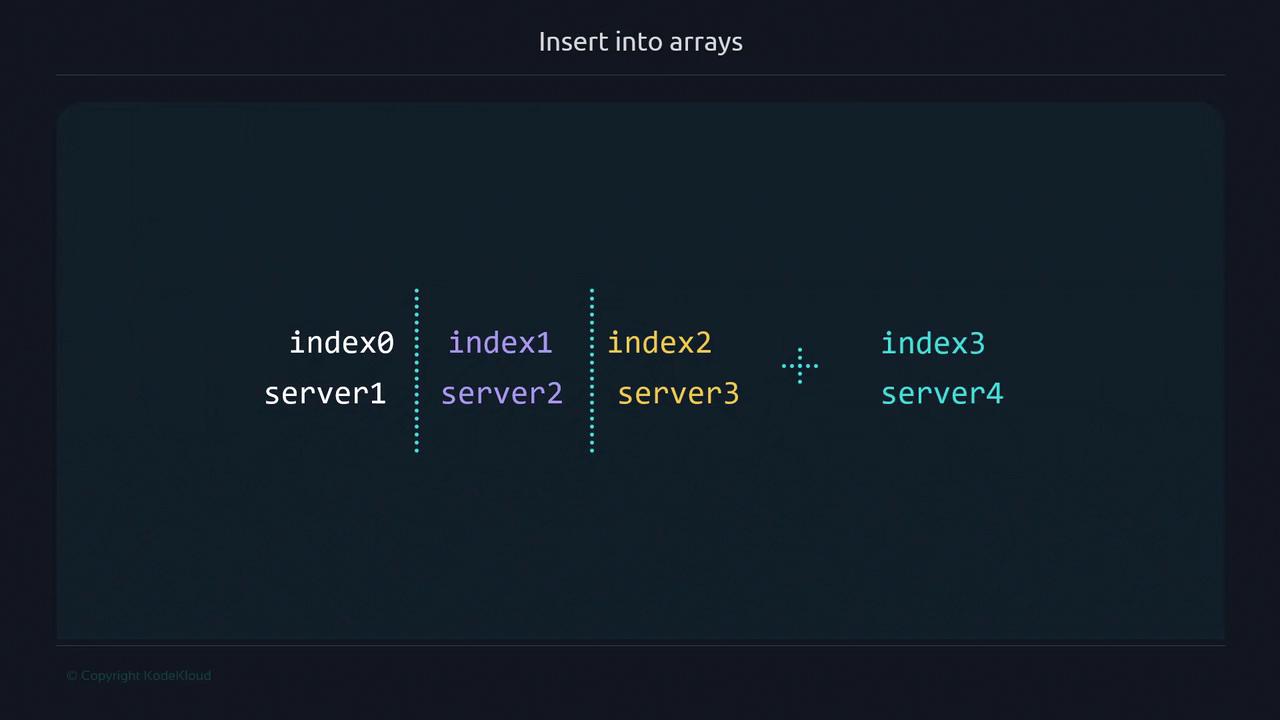Advanced Bash Scripting
Arrays
Insert
In this lesson, you’ll learn how to efficiently manage Bash arrays by adding, replacing, and inserting elements. Bash arrays allow you to store ordered lists of values, making scripts more powerful and flexible.
Table of Contents
- Adding Elements Manually
- Efficient Appending via Parameter Expansion
- Replacing Elements at a Specific Index
- Inserting Elements in the Middle
- Method Comparison
- Links & References
Adding Elements Manually
You can append items by specifying the next index directly. This approach works but requires you to know or calculate the current array length:
#!/usr/bin/env bash
course_sections=("Introduction" "Coding Standards" "Refresher")
course_sections[3]="Streams"
echo "${course_sections[@]}"
$ ./declare7.sh
Introduction Coding Standards Refresher Streams
Example with a servers array:
#!/usr/bin/env bash
declare -a servers=("server1" "server2" "server3")
servers[3]="server4"
echo "${servers[@]}"
$ ./adding.sh
server1 server2 server3 server4
Note
Manually counting indices can lead to errors in larger scripts. Consider using parameter expansion to automate index calculation.
Efficient Appending via Parameter Expansion
Bash provides ${#array[@]} to retrieve the current number of elements. Since arrays are zero-indexed, this value equals the next available index:
#!/usr/bin/env bash
declare -a servers=("server1" "server2" "server3")
# Append at the next free index
servers[${#servers[@]}]="server4"
echo "${servers[@]}"
$ ./sample2.sh
server1 server2 server3 server4

This method automatically calculates the correct index to append, preventing accidental overwrites.
Replacing Elements at a Specific Index
To overwrite an existing element, assign a new value to that index:

#!/usr/bin/env bash
declare -a servers=("server1" "server2" "server3")
servers[1]="serverx"
echo "${servers[@]}"
$ ./array-manipulation3.sh
server1 serverx server3
Warning: Scalar vs Array Assignment
If you omit the index brackets, Bash treats the assignment as a scalar, modifying index 0:
#!/usr/bin/env bash
declare -a servers=("server1" "server2" "server3")
servers="replaced value"
echo "${servers[@]}"
$ ./array-manipulation4.sh
replaced value server2 server3
Inserting Elements in the Middle
To insert an element at a specific position and automatically shift the rest, use array slicing:
#!/usr/bin/env bash
declare -a servers=("server1" "server2" "server3")
# Insert "server1.5" at index 1
servers=(
"${servers[@]:0:1}"
"server1.5"
"${servers[@]:1}"
)
echo "${servers[@]}"
$ ./array-manipulation2.sh
server1 server1.5 server2 server3
Slicing breakdown:
${servers[@]:0:1}→ elements up to (but not including) the insertion point"server1.5"→ new element${servers[@]:1}→ remaining elements from index 1 onward
Method Comparison
| Method | Description | Example |
|---|---|---|
| Manual Indexing | Explicit index assignment; error-prone | servers[3]="server4" |
| Parameter Expansion | Append at next free index | servers[${#servers[@]}]="server4" |
| Array Slicing | Insert at arbitrary position | servers=( "${servers[@]:0:i}" "new" "${servers[@]:i}" ) |
| Direct Variable Assign. | Scalar assignment to index 0 (unexpected) | servers="replaced value" |
Links & References
- Bash Reference Manual
- Bash Scripting Best Practices
- Kubernetes Basics (for scripting in cloud-native environments)
Watch Video
Watch video content